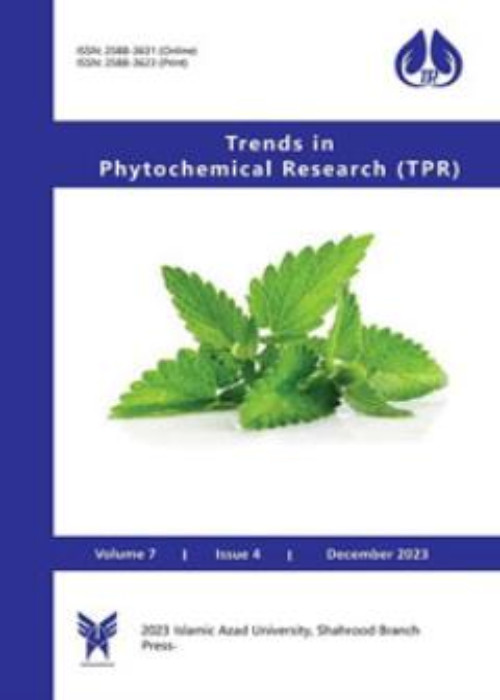فهرست مطالب
Trends in Phytochemical Research
Volume:6 Issue: 3, Summer 2022
- تاریخ انتشار: 1401/07/04
- تعداد عناوین: 6
-
-
Pages 155-186
The genus Micromeria Benth. from the family Lamiaceae mainly comprises herbaceous plants having several remarkable ethnobotanical, biological and phytochemical applications. This review critically appraises all the information available in the literature, e.g., Scopus, Institute for Scientific Information-Web of Science (ISI-WOS) as well as Medline on various species of this genus covering aspects of biological activity, ethnobotanical, chemical taxonomy and phytochemistry. The phytochemical composition of both essential oils and non-volatile extracts is reported. Their chemotaxonomic implications and ethnomedicinal impacts are also discussed. The pharmacological properties of crude extracts and isolated phytochemicals from Mircomeria spp. observed in several bioactivity tests are also critically reviewed. From phytochemical point of view, the characterization of the organic extracts of different Mircomeria spp. has led to the identification of some valuable natural compounds. Furthermore, the chemical profiles of most of the species are dominated by oxygenated monoterpenes. A wide spectrum of promising biological properties have been attributed to Mircomeria species including antibacterial, antifungal, antioxidant, anticholinesterase, tyrosinase inhibition and antinociceptive activities. Moreover, it has been shown that rosmarinic acid serves as a marker compound in several entities of this genus.
Keywords: Biological activity, Chemotaxonomy, Ethnobotany, Micromeria, Phytochemistry -
Pages 187-213
Medicinal herbs, including the Asteraceae family (AF), have different antimicrobial and therapeutic effects. Therefore, they can be used as health factors in the food and medicinal industries. In this systematic review, the essential information was collected from the relevant databases, e.g., PubMed, Sciencedirect, and Google Scholar based on medicinal herbs, AF, essential oil, antimicrobial, antioxidant, therapeutic effect, and Covid-19 keywords. AF can be used as safe preservatives and food additives with a specific amount of consumption in the food industry thanks to their good flavor, antioxidant and antimicrobial effect. Due to their therapeutic effects, they can improve the health role of food. AF herbs contain important bioactive compounds, but not all of them can be used as medicine and food supplements since yarrow, chamomile, and artichoke exhibit toxic effects in high dosage, therefore, the consumption of these herbs should be considered to not endanger the health of the consumer.
Keywords: Antibacterial, Antioxidant, Asteraceae family, Essential oil, Medicinal herbs -
Pages 214-223The essential oil extraction from Citrus peels constitutes an effectual approach for the valorization of Citrus fruit waste. Citrus peel essential oils can have an antifungal activity. The peel essential oils of seven species of Citrus, namely clementine, pummelo, tangelo, sweet orange, sour orange, tangerine and lemon, were extracted by steam distillation and subjected to chemical analysis to identify and evaluate the chemical constituents. Tangerine exhibited the highest yield (1.23%) followed by lemon (0.66%), clementine (0.56%), sweet orange (0.55%), tangelo (0.50%) and sour orange (0.47%). The lowest yield was obtained in pummelo (0.16%). The main compound in all Citrus essential oils was limonene with 62.1% for tangerine, 69.7% for lemon, 72.2% for tangelo, 76.4% for clementine, 89.8% for pummelo, 92.8% for sour orange and 94.1% for sweet orange. All these Citrus essential oils had a weak antifungal activity (MIC = 8000-12000 µg/ml) against Alternaria alternata strain.Keywords: Alternaria alternata, Antifungal activity, Citrus Species, Essential oils, Limonene
-
Pages 224-241
Vitiligo is a depigmenting disorder that causes white patches on the skin and mucosa. It has an impact on a patient’s mental well-being, physical well-being, and human lifestyle. These depigmented macules were originally mentioned in pre-Hindu, Vedic, and ancient Egyptian manuscripts more than 3,000 years ago. In recent years, there has been a growing interest in using phytochemicals over synthetic compounds in the pharmaceutical field. To better understand the effectiveness of natural products in the fight against vitiligo, large-scale clinical trials are required. Here, in this study, we summarize a list of vesicular formulations, with and without phytochemicals, that have been used and will be utilized in the future to treat vitiligo. To assist further progress in this vitiligo review we hereby mention an overview of pathophysiology, recent updates on clinical trials, and patents.
Keywords: Genetics, liposomes, Phytochemical, Pigmentation, Vesicular system, Vitiligo -
Pages 242-247Chemical composition of the essential oil obtained from aerial parts of Tanacetum abrotanifolium (L.) Druce (Asteraceae) was investigated. Plant sample was collected at full flowering stage from West Azerbaijan Province of Iran. The hydrodistilled essential oil was analyzed by GC-FID and GC-MS. The major compounds were found to be (E)-sesquilavandulol (26.6%), camphor (16.2%) and 1,8-cineole (12.9%). Cytotoxicity activity of the oil was evaluated against four cancer cell lines, of which IC50 values estimated to be 312, 312, 625 and 1250 μg oil/mL for the monkey kidney Vero, human breast adenocarcinoma (MCF7), choriocarcinoma (JET 3) and human colon adenocarcinoma (SW480) cell lines, respectively.Keywords: Aerial parts, Asteraceae, Cytotoxicity activity, Essential oil, GC-MS analysis, Tanacetum abrotanifolium
-
Pages 247-258This study was designed to evaluate in vivo and in vitro anti-inflammatory potential of the different extracts of Munronia pinnata and compare it with the isolated compound, Senecrassidiol by using the carrageenan-induced paw edema animal model in Wistar rats. Munronia pinnata (Wall) Theob (Meliaceae) has been traditionally practiced for hundreds of years by traditional physicians as a home remedy for the treatment of inflammatory conditions in folk medicine in Sri Lanka. The tested ethyl acetate fractions of methanol extract and its isolated compound senecrassidiol exhibited significant anti-inflammatory activity in the tested models. It demonstrated the scientific rationale for the use of an anti-inflammatory agent in folk medicine. The MPaq showed a significant (p < 0.5) inhibition of infiltration of rat peritoneal cells, inhibition of NO production by rat peritoneal cells, and inhibition of membrane stabilization as well as the anti-histamine activity which are the probable anti-inflammatory mechanisms.Keywords: Anti-inflammatory, Folk medicine, Membrane stabilization, Munronia pinnata, Senecrassidiol, Wistar Rats


